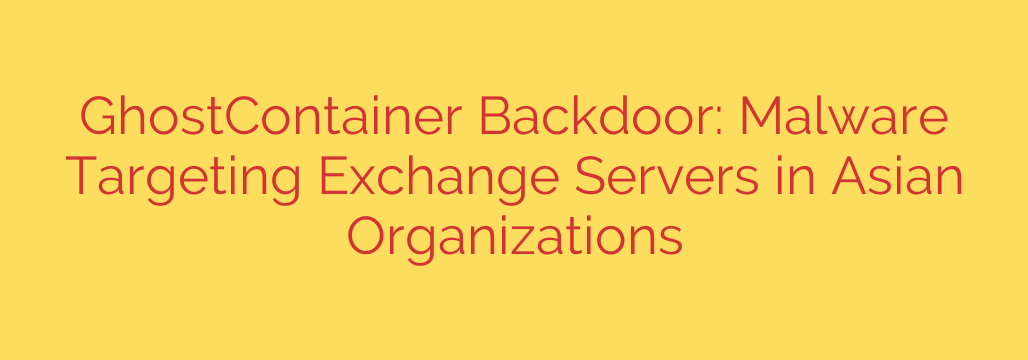
GhostContainer: The New Stealth Backdoor Targeting Microsoft Exchange Servers
In the ever-evolving landscape of cybersecurity, a sophisticated new threat has emerged, specifically designed to compromise high-value targets. Known as the GhostContainer backdoor, this malware is engineered for stealth, persistence, and deep network infiltration, with a primary focus on Microsoft Exchange servers.
Understanding this threat is the first step toward building a robust defense. This article breaks down what GhostContainer is, how it operates, and the critical steps your organization must take to protect its vital infrastructure.
What is the GhostContainer Backdoor?
GhostContainer is a custom-designed backdoor that gives attackers persistent and remote control over a compromised system. Unlike common, off-the-shelf malware, it appears to be part of a targeted campaign aimed at espionage and data exfiltration.
Its name hints at its primary characteristics:
- “Ghost”: Refers to its advanced evasion techniques. The malware goes to great lengths to hide its presence, avoid detection by security software, and operate silently in the background.
- “Container”: Suggests its modular nature and its ability to create a concealed environment for malicious activities within the infected system.
The ultimate goal of this backdoor is to establish a permanent foothold in a victim’s network. From there, attackers can steal sensitive data, monitor communications, and pivot to other systems within the organization.
The Attack Chain: From Vulnerability to Control
GhostContainer’s primary infection vector relies on a well-established attack pattern against email servers. The infiltration typically follows these stages:
- Exploiting Vulnerabilities: Attackers first gain initial access by exploiting known, and often unpatched, vulnerabilities in public-facing Microsoft Exchange servers. Flaws like ProxyLogon and ProxyShell have been common entry points for similar attacks.
- Webshell Deployment: Once inside, the attackers deploy a webshell—a malicious script that allows them to execute commands on the server remotely. This webshell acts as a simple, early-stage tool to prepare the environment.
- Backdoor Installation: Using the webshell, the attackers then download and install the more sophisticated GhostContainer backdoor. This is the key component that ensures their access persists even if the original vulnerability is patched or the webshell is discovered.
- Establishing Persistence: GhostContainer is designed to survive system reboots and security scans. It often disguises itself as a legitimate system process or service, making it difficult for administrators to spot during routine checks.
By targeting Exchange servers, attackers gain access to an organization’s central nervous system for communication, including emails, calendars, and contact lists—a treasure trove for cyber espionage.
Key Characteristics of GhostContainer Malware
This backdoor isn’t just another piece of malware; its design showcases a high level of sophistication. Here are some of its defining features:
- Advanced Evasion: The malware actively works to stay hidden. It may use techniques like running in memory (fileless execution) or using names and file paths that mimic legitimate Windows components to blend in.
- Encrypted Communications: All communication between the infected server and the attackers’ command-and-control (C2) infrastructure is heavily encrypted. This prevents network monitoring tools from easily identifying malicious traffic.
- Living-off-the-Land Techniques: GhostContainer often abuses legitimate system administration tools already present on the server, such as PowerShell or Windows Management Instrumentation (WMI). This “living-off-the-land” approach makes its activities appear as normal administrative tasks, further complicating detection.
- Targeted Deployment: Current analysis indicates that GhostContainer is not being spread indiscriminately. Instead, it is selectively deployed against organizations in Asia, suggesting a focused campaign by a specific threat actor, likely for intelligence-gathering purposes.
How to Defend Against GhostContainer and Similar Threats
Protecting your organization from a threat as stealthy as GhostContainer requires a proactive and multi-layered security strategy. Waiting for a breach to occur is not an option. Here are actionable steps you should implement immediately:
- Patch Your Exchange Servers Immediately: This is the single most important defense. Threat actors rely on organizations running outdated and vulnerable software. Apply all security updates for Microsoft Exchange and other critical systems without delay.
- Conduct Regular Security Audits: Actively hunt for threats. Regularly scan your servers for webshells, unknown scheduled tasks, and unusual outbound network connections. Look for suspicious processes masquerading as legitimate services.
- Implement Robust Endpoint Security: Deploy an Endpoint Detection and Response (EDR) or Extended Detection and Response (XDR) solution. These tools provide deeper visibility into system processes and can detect the anomalous behavior associated with backdoors like GhostContainer.
- Enforce the Principle of Least Privilege: Ensure that accounts, especially service accounts, have only the minimum permissions necessary to perform their functions. This can limit an attacker’s ability to move laterally within your network after an initial compromise.
- Use Multi-Factor Authentication (MFA): Enable MFA on all administrative accounts and, where possible, for all users. This adds a critical layer of security that can prevent attackers from using stolen credentials to access sensitive systems.
- Monitor Network Traffic: Closely monitor outbound traffic from critical servers like your Exchange server. Any connections to unknown or suspicious IP addresses should be investigated immediately.
The emergence of GhostContainer is a stark reminder that Microsoft Exchange servers remain a top target for sophisticated threat actors. Vigilance, proactive patching, and a defense-in-depth security model are essential to protecting your organization’s most critical assets from these invisible threats.
Source: https://securelist.com/ghostcontainer/116953/








